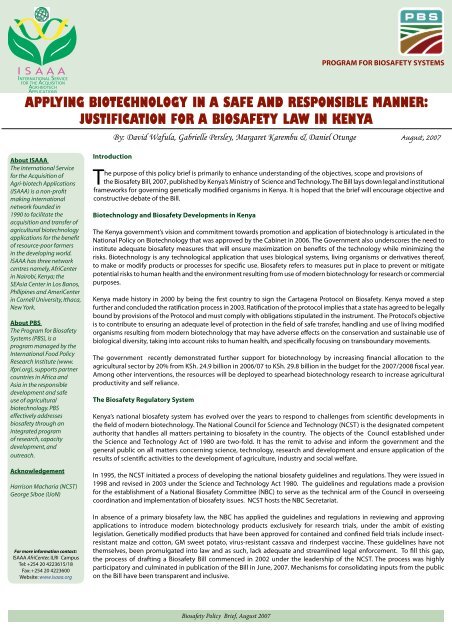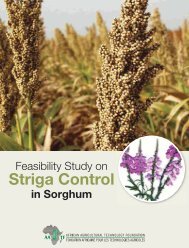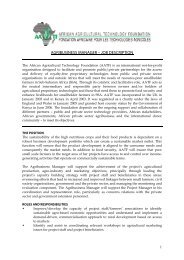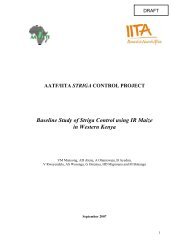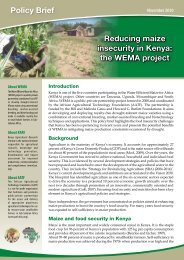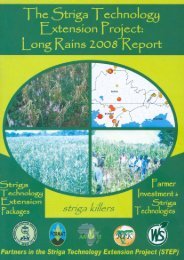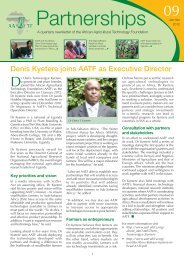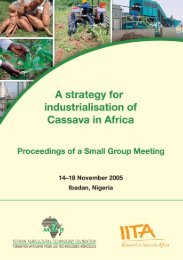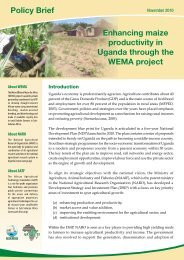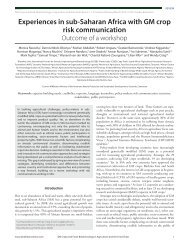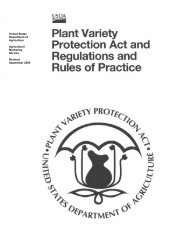justification for a biosafety law in kenya
justification for a biosafety law in kenya
justification for a biosafety law in kenya
You also want an ePaper? Increase the reach of your titles
YUMPU automatically turns print PDFs into web optimized ePapers that Google loves.
PROGRAM FOR BIOSAFETY SYSTEMS<br />
APPLYING BIOTECHNOLOGY IN A SAFE AND RESPONSIBLE MANNER:<br />
JUSTIFICATION FOR A BIOSAFETY LAW IN KENYA<br />
By: David Wafula, Gabrielle Persley, Margaret Karembu & Daniel Otunge<br />
August, 2007<br />
About ISAAA<br />
The International Service<br />
<strong>for</strong> the Acquisition of<br />
Agri-biotech Applications<br />
(ISAAA) is a non-profit<br />
mak<strong>in</strong>g <strong>in</strong>ternational<br />
network founded <strong>in</strong><br />
1990 to facilitate the<br />
acquisition and transfer of<br />
agricultural biotechnology<br />
applications <strong>for</strong> the benefit<br />
of resource-poor farmers<br />
<strong>in</strong> the develop<strong>in</strong>g world.<br />
ISAAA has three network<br />
centres namely, AfriCenter<br />
<strong>in</strong> Nairobi, Kenya; the<br />
SEAsia Center <strong>in</strong> Los Banos,<br />
Phllip<strong>in</strong>es and AmeriCenter<br />
<strong>in</strong> Cornell University, Ithaca,<br />
New York.<br />
About PBS<br />
The Program <strong>for</strong> Biosafety<br />
Systems (PBS), is a<br />
program managed by the<br />
International Food Policy<br />
Research Institute (www.<br />
ifpri.org), supports partner<br />
countries <strong>in</strong> Africa and<br />
Asia <strong>in</strong> the responsible<br />
development and safe<br />
use of agricultural<br />
biotechnology. PBS<br />
effectively addresses<br />
<strong>biosafety</strong> through an<br />
<strong>in</strong>tegrated program<br />
of research, capacity<br />
development, and<br />
outreach.<br />
Acknowledgement<br />
Harrison Macharia (NCST)<br />
George Siboe (UoN)<br />
For more <strong>in</strong><strong>for</strong>mation contact:<br />
ISAAA AfriCenter, ILRI Campus<br />
Tel: +254 20 4223615/18<br />
Fax: +254 20 4223600<br />
Website: www.isaaa.org<br />
Introduction<br />
The purpose of this policy brief is primarily to enhance understand<strong>in</strong>g of the objectives, scope and provisions of<br />
the Biosafety Bill, 2007, published by Kenya’s M<strong>in</strong>istry of Science and Technology. The Bill lays down legal and <strong>in</strong>stitutional<br />
frameworks <strong>for</strong> govern<strong>in</strong>g genetically modified organisms <strong>in</strong> Kenya. It is hoped that the brief will encourage objective and<br />
constructive debate of the Bill.<br />
Biotechnology and Biosafety Developments <strong>in</strong> Kenya<br />
The Kenya government’s vision and commitment towards promotion and application of biotechnology is articulated <strong>in</strong> the<br />
National Policy on Biotechnology that was approved by the Cab<strong>in</strong>et <strong>in</strong> 2006. The Government also underscores the need to<br />
<strong>in</strong>stitute adequate <strong>biosafety</strong> measures that will ensure maximization on benefits of the technology while m<strong>in</strong>imiz<strong>in</strong>g the<br />
risks. Biotechnology is any technological application that uses biological systems, liv<strong>in</strong>g organisms or derivatives thereof,<br />
to make or modify products or processes <strong>for</strong> specific use. Biosafety refers to measures put <strong>in</strong> place to prevent or mitigate<br />
potential risks to human health and the environment result<strong>in</strong>g from use of modern biotechnology <strong>for</strong> research or commercial<br />
purposes.<br />
Kenya made history <strong>in</strong> 2000 by be<strong>in</strong>g the first country to sign the Cartagena Protocol on Biosafety. Kenya moved a step<br />
further and concluded the ratification process <strong>in</strong> 2003. Ratification of the protocol implies that a state has agreed to be legally<br />
bound by provisions of the Protocol and must comply with obligations stipulated <strong>in</strong> the <strong>in</strong>strument. The Protocol’s objective<br />
is to contribute to ensur<strong>in</strong>g an adequate level of protection <strong>in</strong> the field of safe transfer, handl<strong>in</strong>g and use of liv<strong>in</strong>g modified<br />
organisms result<strong>in</strong>g from modern biotechnology that may have adverse effects on the conservation and susta<strong>in</strong>able use of<br />
biological diversity, tak<strong>in</strong>g <strong>in</strong>to account risks to human health, and specifically focus<strong>in</strong>g on transboundary movements.<br />
The government recently demonstrated further support <strong>for</strong> biotechnology by <strong>in</strong>creas<strong>in</strong>g f<strong>in</strong>ancial allocation to the<br />
agricultural sector by 20% from KSh. 24.9 billion <strong>in</strong> 2006/07 to KSh. 29.8 billion <strong>in</strong> the budget <strong>for</strong> the 2007/2008 fiscal year.<br />
Among other <strong>in</strong>terventions, the resources will be deployed to spearhead biotechnology research to <strong>in</strong>crease agricultural<br />
productivity and self reliance.<br />
The Biosafety Regulatory System<br />
Kenya’s national <strong>biosafety</strong> system has evolved over the years to respond to challenges from scientific developments <strong>in</strong><br />
the field of modern biotechnology. The National Council <strong>for</strong> Science and Technology (NCST) is the designated competent<br />
authority that handles all matters perta<strong>in</strong><strong>in</strong>g to <strong>biosafety</strong> <strong>in</strong> the country. The objects of the Council established under<br />
the Science and Technology Act of 1980 are two-fold. It has the remit to advise and <strong>in</strong><strong>for</strong>m the government and the<br />
general public on all matters concern<strong>in</strong>g science, technology, research and development and ensure application of the<br />
results of scientific activities to the development of agriculture, <strong>in</strong>dustry and social welfare.<br />
In 1995, the NCST <strong>in</strong>itiated a process of develop<strong>in</strong>g the national <strong>biosafety</strong> guidel<strong>in</strong>es and regulations. They were issued <strong>in</strong><br />
1998 and revised <strong>in</strong> 2003 under the Science and Technology Act 1980. The guidel<strong>in</strong>es and regulations made a provision<br />
<strong>for</strong> the establishment of a National Biosafety Committee (NBC) to serve as the technical arm of the Council <strong>in</strong> oversee<strong>in</strong>g<br />
coord<strong>in</strong>ation and implementation of <strong>biosafety</strong> issues. NCST hosts the NBC Secretariat.<br />
In absence of a primary <strong>biosafety</strong> <strong>law</strong>, the NBC has applied the guidel<strong>in</strong>es and regulations <strong>in</strong> review<strong>in</strong>g and approv<strong>in</strong>g<br />
applications to <strong>in</strong>troduce modern biotechnology products exclusively <strong>for</strong> research trials, under the ambit of exist<strong>in</strong>g<br />
legislation. Genetically modified products that have been approved <strong>for</strong> conta<strong>in</strong>ed and conf<strong>in</strong>ed field trials <strong>in</strong>clude <strong>in</strong>sectresistant<br />
maize and cotton, GM sweet potato, virus-resistant cassava and r<strong>in</strong>derpest vacc<strong>in</strong>e. These guidel<strong>in</strong>es have not<br />
themselves, been promulgated <strong>in</strong>to <strong>law</strong> and as such, lack adequate and streaml<strong>in</strong>ed legal en<strong>for</strong>cement. To fill this gap,<br />
the process of draft<strong>in</strong>g a Biosafety Bill commenced <strong>in</strong> 2002 under the leadership of the NCST. The process was highly<br />
participatory and culm<strong>in</strong>ated <strong>in</strong> publication of the Bill <strong>in</strong> June, 2007. Mechanisms <strong>for</strong> consolidat<strong>in</strong>g <strong>in</strong>puts from the public<br />
on the Bill have been transparent and <strong>in</strong>clusive.<br />
Biosafety Policy Brief, August 2007
The objectives, scope and provisions of the<br />
Biosafety Bill<br />
The Biosafety Bill is consistent with the provisions<br />
and requirements of the Convention on<br />
Biological Diversity and the Cartagena Protocol<br />
on Biosafety. The objectives of the Bill are to<br />
ensure an adequate level of protection <strong>in</strong> the field<br />
of safe transfer, handl<strong>in</strong>g and use of genetically<br />
modified organisms that may have an adverse<br />
effect on human health and environment, and<br />
to establish a transparent science-based and<br />
predictable process to review and make decisions<br />
on genetically modified organisms and related<br />
activities.<br />
In terms of scope, the Bill covers conta<strong>in</strong>ed use,<br />
deliberate release, plac<strong>in</strong>g on the market, import<br />
and export of GMOs and products conta<strong>in</strong><strong>in</strong>g<br />
GMOs. The legal requirements and procedures<br />
required <strong>for</strong> obta<strong>in</strong><strong>in</strong>g approval be<strong>for</strong>e<br />
<strong>in</strong>troduc<strong>in</strong>g GMOs <strong>for</strong> research or commercial<br />
purposes are specified. The Bill elaborates on the<br />
<strong>in</strong><strong>for</strong>mation required from the applicants, the<br />
risk assessment process and the role of different<br />
regulatory agencies <strong>in</strong> ensur<strong>in</strong>g compliance.<br />
The Bill makes provision <strong>for</strong> establishment<br />
of a competent authority to be known as<br />
the National Biosafety Authority (NBA). The<br />
Authority shall be under the M<strong>in</strong>istry of Science<br />
and Technology and will be managed by a<br />
board compris<strong>in</strong>g em<strong>in</strong>ent scientists, experts,<br />
permanent secretaries from key m<strong>in</strong>istries, the<br />
secretary NCST, directors of <strong>biosafety</strong> regulatory<br />
agencies and civil society representatives. Key<br />
functions of the authority embrace overall<br />
supervision and control of the development,<br />
transfer, handl<strong>in</strong>g and use of genetically modified<br />
organisms <strong>for</strong> research or commercial purposes.<br />
The proposed Authority is also charged with the<br />
responsibility of promot<strong>in</strong>g public awareness<br />
and education to enhance understand<strong>in</strong>g of<br />
<strong>biosafety</strong>. The Bill outl<strong>in</strong>es mechanisms <strong>for</strong><br />
obta<strong>in</strong><strong>in</strong>g and <strong>in</strong>corporat<strong>in</strong>g public <strong>in</strong>put<br />
<strong>in</strong>to the decision mak<strong>in</strong>g process. Notices will<br />
be published <strong>in</strong> the Kenya Gazette to <strong>in</strong>vite<br />
comments and <strong>in</strong>puts from the public on<br />
decisions to approve <strong>in</strong>troduction of GMOs <strong>for</strong><br />
research or commercial purposes.<br />
The NBA will operate as a full-fledged body<br />
with f<strong>in</strong>ancial autonomy and <strong>in</strong>stitutional<br />
permanency. F<strong>in</strong>ancial provisions <strong>in</strong> the<br />
Bill def<strong>in</strong>e sources of funds <strong>for</strong> the Authority<br />
which <strong>in</strong>cludes appropriations by Parliament.<br />
The Authority is also mandated to solicit<br />
<strong>for</strong> additional funds from other sources to<br />
strengthen f<strong>in</strong>ancial stability. The provisions<br />
will enhance capacity build<strong>in</strong>g <strong>in</strong> relevant areas<br />
of scientific expertise, ensure compliance and<br />
strengthen monitor<strong>in</strong>g and en<strong>for</strong>cement of<br />
<strong>biosafety</strong> matters <strong>in</strong> Kenya.<br />
To ensure safe and responsible use, the Bill makes<br />
provision <strong>for</strong> assessment and management of<br />
risks that may be caused by genetically modified<br />
organisms. The Bill imposes heavy penalties to<br />
persons deal<strong>in</strong>g <strong>in</strong> GMOs without approval of the<br />
authority or fail to furnish correct <strong>in</strong><strong>for</strong>mation<br />
to the authority. Cessation orders stipulate<br />
immediate directives <strong>for</strong> term<strong>in</strong>at<strong>in</strong>g activities<br />
that pose imm<strong>in</strong>ent danger to the conservation<br />
and susta<strong>in</strong>able use of biological diversity, tak<strong>in</strong>g<br />
<strong>in</strong>to account risks to human health.<br />
Environmental restoration orders set <strong>for</strong>th legal<br />
sanctions to be en<strong>for</strong>ced to remedy or rehabilitate<br />
damage to the environment as a result of<br />
negligence or deviation from risk management<br />
measures.<br />
Why Kenya needs a Biosafety Law<br />
The need and importance of a <strong>biosafety</strong> legislation<br />
<strong>in</strong> Kenya is justified by a number of fundamental<br />
reasons. A comprehensive <strong>biosafety</strong> legal<br />
framework strikes a balance amongst ensur<strong>in</strong>g<br />
the development of biotechnology, protection<br />
of the environment and safeguard<strong>in</strong>g the<br />
<strong>in</strong>terests of consumers. Potential risks associated<br />
with application of modern biotechnology<br />
are m<strong>in</strong>imized while facilitat<strong>in</strong>g the beneficial<br />
application of the technology <strong>in</strong> areas of<br />
agriculture, health, environment and <strong>in</strong>dustry.<br />
The <strong>law</strong> is vital to deal with transboundary<br />
movement of GMOs. For <strong>in</strong>stance, delays caused<br />
by judicial and political decisions resulted to<br />
an <strong>in</strong>crease <strong>in</strong> illegal plant<strong>in</strong>g of GM soyabean<br />
seeds <strong>in</strong> southern Brazil smuggled across the<br />
border from Argent<strong>in</strong>a. Appropriate legislation<br />
and a strong regulatory framework are also<br />
important <strong>in</strong> develop<strong>in</strong>g public confidence <strong>in</strong><br />
biotechnology as a technological option.<br />
National <strong>law</strong>s and regulations are required <strong>in</strong><br />
order to fulfill and comply with the objectives<br />
of the Cartagena Protocol on Biosafety.<br />
Parties are required to make available to the<br />
Biosafety Clear<strong>in</strong>g-House copies of any national<br />
<strong>law</strong>s, regulations and guidel<strong>in</strong>es affect<strong>in</strong>g<br />
transboundary movement of GMOs. Over the<br />
years, the Kenya Government has enacted<br />
several <strong>law</strong>s. However, these <strong>law</strong>s lack specific<br />
provisions related to the safe application of<br />
modern biotechnology especially on issues<br />
<strong>in</strong>volv<strong>in</strong>g genetic eng<strong>in</strong>eer<strong>in</strong>g and its products<br />
thereof.<br />
Exist<strong>in</strong>g Acts and regulations be<strong>in</strong>g employed<br />
to some extent, to facilitate application of<br />
biotechnology were enacted at a time when<br />
the technology was not a major public policy<br />
concern. In the last decade, scientific and<br />
technological developments <strong>in</strong> the field of<br />
modern biotechnology have been significant. At<br />
the same time, debates on benefits and risks of<br />
this technology have ga<strong>in</strong>ed currency. Draft<strong>in</strong>g<br />
of the Biosafety Bill took <strong>in</strong>to consideration<br />
<strong>biosafety</strong> regulatory gaps <strong>in</strong> exist<strong>in</strong>g pieces of<br />
legislation and sought to address these gaps.<br />
Conf<strong>in</strong>ed field trials of genetically-modified<br />
<strong>in</strong>sect-resistant cotton and maize are go<strong>in</strong>g on<br />
<strong>in</strong> Kenya. While these products are approach<strong>in</strong>g<br />
the commercialization phase, the Science and<br />
Technology Act of 1980, under which <strong>biosafety</strong><br />
regulations are currently be<strong>in</strong>g applied lacks<br />
substantive provisions to move on-go<strong>in</strong>g<br />
Biosafety Policy Brief, August 2007<br />
research products from research stage to<br />
commercialization. Enactment of <strong>biosafety</strong><br />
legislation would ensure that commercial<br />
release of potentially beneficial products is<br />
done <strong>in</strong> a safe and responsible manner. In the<br />
absence of the legislation, protracted delays <strong>in</strong><br />
commercializ<strong>in</strong>g products whose efficacy and<br />
safety have been scientifically proven, would<br />
deny farmers present and future options and<br />
choices to ga<strong>in</strong> higher <strong>in</strong>come from GM crops,<br />
and to protect the environment by reduced use<br />
of pesticides.<br />
The rapid adoption of biotech crops reflects<br />
the substantial benefits realized by farmers<br />
<strong>in</strong> both develop<strong>in</strong>g and <strong>in</strong>dustrialized<br />
countries and farmers’ satisfaction and<br />
confidence <strong>in</strong> the technology. The overall<br />
relevance and contribution of biotech crops<br />
to susta<strong>in</strong>able development and food security<br />
<strong>in</strong> complement<strong>in</strong>g other tools of modern<br />
agriculture is outstand<strong>in</strong>g. Trends depict<br />
that approximately 10.3 million farmers <strong>in</strong><br />
develop<strong>in</strong>g countries (<strong>in</strong>clud<strong>in</strong>g South Africa,<br />
Ch<strong>in</strong>a and India) grew biotech crops <strong>in</strong> 2006, up<br />
significantly from 5 million farmers <strong>in</strong> 2002. The<br />
number of countries that are grow<strong>in</strong>g biotech<br />
crops <strong>in</strong>creased from 6 <strong>in</strong> 1996 to 22 <strong>in</strong> 2006.<br />
This <strong>in</strong>cludes six countries <strong>in</strong> the European<br />
Union (Spa<strong>in</strong>, France, Czech Republic, Portugal,<br />
Germany and Slovakia) where the degree of<br />
sensitivity and controversy associated with<br />
GMOs is high. The global area under biotech<br />
crops also <strong>in</strong>creased significantly from 4.2 million<br />
acres <strong>in</strong> 1996 to 252 million acres <strong>in</strong> 2006 (over a<br />
50-fold <strong>in</strong>crease).<br />
S<strong>in</strong>ce 1996, biotech crops have <strong>in</strong>creased farm<br />
<strong>in</strong>comes by USD 27 billion world wide. An<br />
Economic analysis study on potential benefits<br />
of biotech crops commissioned by the Common<br />
Market <strong>for</strong> Eastern and Southern Africa (COMESA)<br />
revealed that farmers’ <strong>in</strong>comes <strong>in</strong> Kenya would<br />
<strong>in</strong>crease by USD 5.9 million and food security<br />
situation enhanced substancially if they<br />
adopted <strong>in</strong>sect resistant genetically modified<br />
varieties of cotton and maize compared to the<br />
conventional counter parts.<br />
Conclusion<br />
The Biosafety Bill and the National<br />
Biotechnology Policy are the cornerstones of<br />
Kenya’s national biotechnology regulatory<br />
system. The implementation and en<strong>for</strong>cement<br />
of the two <strong>in</strong>struments is <strong>in</strong>dispensable if<br />
Kenya is to become a competitive participant<br />
and beneficiary <strong>in</strong> this global biotechnology<br />
revolution. The absence of a <strong>biosafety</strong> <strong>law</strong><br />
exposes the country to regulatory gaps and<br />
could be a major weakness underm<strong>in</strong><strong>in</strong>g<br />
the legitimacy and credibility of the national<br />
<strong>biosafety</strong> system. In this respect, enactment<br />
of a <strong>biosafety</strong> <strong>law</strong> <strong>in</strong> Kenya is fundamental<br />
to provide adequate legal authority and<br />
en<strong>for</strong>cement. This would provide an enabl<strong>in</strong>g<br />
environment <strong>for</strong> modern biotechnology<br />
research and development to thrive and at the<br />
same time safeguard the country from potential<br />
risks posed by the technology.


